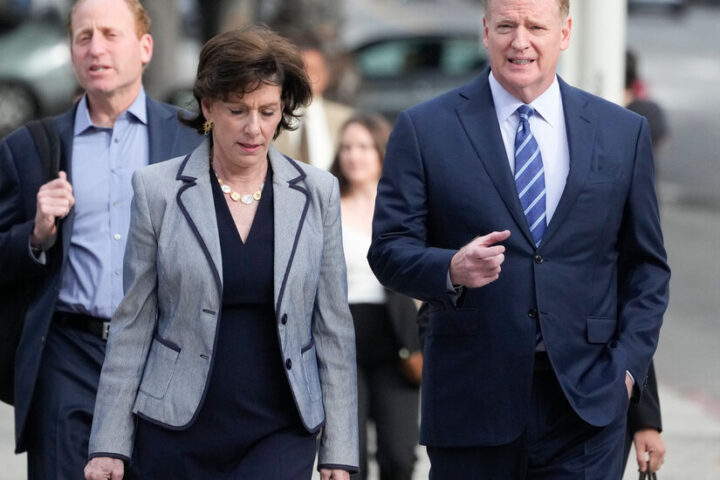The Los Angeles Chargers often get labeled as snakebit. But is that the truth, or does the reality of being overrated fit a bit better?
Nobody gets more springtime love than the Los Angeles Chargers. Nobody leaves prognosticators more dumbfounded come Christmas.
It’s an annual dance with the Chargers. Big sizzle, little steak. It’s become a punchline.
The question is whether Los Angeles is incredibly unlucky, or plain overrated. Or are they both?
Like every large company, start at the top. John Spanos took control of the Chargers in 2015 from his father, Dean. Since then, L.A. has made one playoff appearance, and enjoyed two winning seasons.
Under Spanos, the Chargers have employed only Tom Telesco as general manager, who has been in that post since 2013. Telesco has long been lauded for his drafting, highlighted by brilliant first-round picks including quarterback Justin Herbert, edge rusher Joey Bosa, safety Derwin James, left tackle Rashawn Slater and receiver Mike Williams.
However, the Chargers have gotten little in the draft once the first 32 picks click off. Since 2016, Telesco has not drafted a single Pro Bowler from the second round on.
This offseason, the Chargers decided to bolster their roster in an uncharacteristic spending spree. They first signed corner J.C. Jackson to a five-year, $82.5 million deal at the outset of free agency. Two days later, Telesco traded for edge rusher Khalil Mack, taking on $63.9 million in cap numbers over the next three years in exchange for second- and sixth-round picks.
Los Angeles then rounded out its offseason by signing veterans in corner Bryce Callahan, defensive tackle Sebastian Joseph-Day and linebacker Kyle Van Noy, before extending James on a market-resetting extension of four years and $76.2 million.
Most teams with a rookie quarterback are well below the salary cap. Next year, with the cap projected at $225 million, Los Angeles is $3.3 million in the red with 39 players under contract. Factor in Herbert’s eventual extension — which three prominent agents all independently told FanSided they believe could be $55 million annually — and the days of swinging big through trades and free agency are over.
Due to Telesco’s inability to find quality players in later rounds, Los Angeles was forced to relinquish assets including financial and draft capital to procure ample outside talent.
The result is the Chargers are top-heavy and expensive. It makes for a great marquee, but an underwhelming supporting cast.
This is where the oft-talked about topic of injuries comes in. Already, the Chargers have placed Bosa and Slater on IR, with the latter gone for the year with a biceps tear. Allen has played one half of football due to a hamstring pull, Jackson has missed all but one game since late August with an ankle ailment, and Herbert is dealing with fractured rib cartilage sustained in Week 2 against Kansas City.
And when injuries happen, Los Angeles’ talent gap between starter and reserve is among the most-glaring in the NFL. While some will say the caliber of player lost to Los Angeles is where the luck comes in, the belief is also somewhat rooted in fallacy.
While Herbert, Slater and Jackson have always been healthy in their NFL careers, Bosa and Allen have long histories of injury issues.
Bosa hasn’t played in 17 games through the first six years of his time with the Chargers, and will now miss more. Allen has been sidelined for 30 games since 2013, albeit with better health since tearing his ACL in ’16. Thankfully, both Williams and James have been healthy this season, but the duo has combined to miss 37 games (29 from James) in their 11 years with the Chargers.
Los Angeles has left itself vulnerable to crushing injuries more than most with its high-end talent. When that unfortunately becomes a near-annual reality, that’s not bad fortune, that’s bad planning.
And this problem hasn’t been helped by Telesco’s inability to find a high-end head coach.
During his tenure, Telesco has hired three head coaches in Mike McCoy, Anthony Lynn and Brandon Staley. McCoy had a pair of nine-win teams inheriting loaded rosters, before winning nine total games over his final two seasons at the helm. Lynn also posted a pair of winning seasons to begin his tenure — highlighted by 12 victories in ’18 — before five- and seven-win campaigns sparked more change.
Now there’s Staley, who is 10-10 through 20 games. While the record is average, the decision-making is not. Staley hired Joe Lombardi as his offensive coordinator, an enormous job on Staley’s staff considering the head coach’s defensive background.
Under Lombardi, the Chargers ranked 19th last year in average depth of target (ADOT) despite having Herbert throwing to Keenan Allen and Williams. This season, Los Angeles checks in 26th in ADOT. The offense also struggles to run the ball, despite facing light box counts. The Chargers are generating a league-worst 2.6 yards per carry, with no other team below 3.3 YPC.
Then there’s Staley playing Herbert down 38-10 last weekend in a blowout loss to the Jacksonville Jaguars, despite Slater being out and his quarterback dealing with painful ribs. Afterwards, Staley said Herbert wanted to remain in the game. While Herbert’s courage is commendable, Staley’s literal job is to make the best team decision. There’s no argument this was wise.
So, back to the question. Unlucky, or overrated?
There’s an old saying which says failing to prepare is preparing to fail.
By not drafting well in the middle and late rounds, the Chargers have created a thin roster populated by stars, but many of whom have been susceptible to injuries.
The Chargers have been unlucky at times, but they’ve set themselves up for failure.



